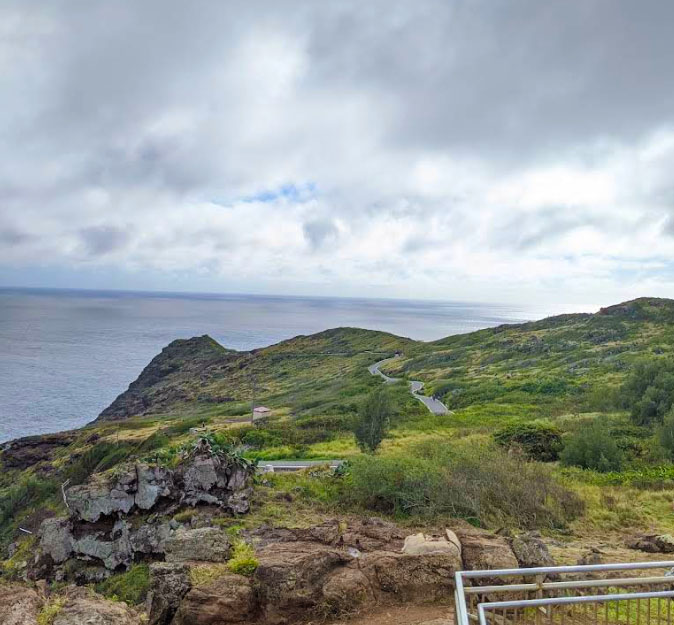Makapuʻu Lighthouse trail is one of Oahu’s most approachable hikes for families, multi-generational groups, and visitors with mobility considerations. It’s fully paved, free to enter, and rewards you with big ocean views almost immediately. That said, it’s also exposed to sun and wind and gains roughly 500 feet over the one-mile climb to the lookouts – so a little planning goes a long way.
The trail follows a wide, fully paved service road from the parking area to the upper lookouts. The paving is smooth enough for strollers and most mobility aids, and the width comfortably allows two people to walk side-by-side for most of the route. There are no stairs anywhere on the trail. Instead, you’ll experience a steady, continuous incline for roughly a mile, then the same grade in reverse on the way down. The slope feels gentle at first and gradually becomes more noticeable near the final bends before the lookouts. Plan short breathers at pullouts or interpretive signs rather than long stops in the full sun.
Because the trail is exposed, trade winds funnel across the ridgeline – especially near the top and at the guard-railed viewpoints. Secure brimmed hats, keep a hand on small children, and set trekking-pole tips wide for stability if you use them. On windy days, the downhill can feel faster than expected: take shorter steps, keep your weight slightly forward, and avoid letting a stroller or excited kids build speed on the grade.
Footing is generally excellent, but wind can blow grit, sand, or dry leaves onto the surface, making some corners a little slick. Closed-toe shoes with modest tread (light hikers or grippy sneakers) are ideal. Since there’s no shade, the pavement radiates heat by late morning; start earlier or later in the day for a cooler, more comfortable climb.

Strollers, Baby carriers & young walkers

A stroller can make this outing far more comfortable for young kids.
- Best choice: A jogging/all-terrain stroller with a hand brake and wrist tether to control speed on the descent.
- Technique: Take short, deliberate steps on the way down; don’t let the stroller pull ahead.
- Wind awareness: Gusts can be strong—use two hands and angle the stroller slightly into the wind when you stop.
- Know when to turn around: If little legs tire or wind picks up, the lower half of the trail already delivers sweeping views. A shorter out-and-back still feels like a win.
For infants and toddlers, a structured front or back carrier keeps your hands free for balance. Pack a brimmed hat and sun layer for the child, and a light fleece if trade winds feel cool. For early walkers, plan short breaks every 5–10 minutes at pullouts – snacks and “view stops” make great mini-milesto
Wheelchairs & mobility aids
The smooth paving helps many visitors using mobility devices enjoy at least part of the hike. The sustained slope and frequent winds can be challenging:
- Manual wheelchair users may appreciate a companion to assist on steeper stretches and to help manage crosswinds.
- Powered chairs typically handle the surface well; consider turning around wherever the grade becomes tiring.
The lower viewpoints provide excellent scenery without committing to the full climb.